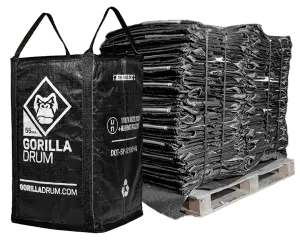 When transporting or storing hazardous materials, safety is never optional. Every container used in these processes must meet strict government standards to ensure hazardous waste is packaged and handled correctly. A DOT approved drum refers to a container that meets all U.S. Department of Transportation (DOT) performance requirements for transporting dangerous goods.
When transporting or storing hazardous materials, safety is never optional. Every container used in these processes must meet strict government standards to ensure hazardous waste is packaged and handled correctly. A DOT approved drum refers to a container that meets all U.S. Department of Transportation (DOT) performance requirements for transporting dangerous goods.
Understanding what makes a drum DOT approved helps facilities maintain compliance, avoid costly fines, and ensure that hazardous materials are stored and transported safely. Whether you use hazmat drums, a 55 gallon hazmat drum, or other types of hazmat storage drums, DOT approval is a vital aspect of responsible hazardous waste management. Gorilla Drum provides containers that meet both DOT and UN performance standards for a safer and more efficient way to manage waste.
What Does DOT Approval Mean?
A DOT approved drum has passed specific performance and design tests set by the Department of Transportation. These tests are designed to ensure that the container can safely transport hazardous materials without leaking, rupturing, or failing under normal transportation conditions.
DOT approval means the drum is suitable for use in the shipment of regulated substances over public roads, railways, or waterways. It guarantees that the container complies with federal regulations in Title 49 of the Code of Federal Regulations (49 CFR), which governs the packaging and transport of hazardous materials in the United States.
Simply put, DOT approval verifies that a hazardous waste drum can withstand the demands of real-world transport without compromising safety.
The Relationship Between DOT and UN Ratings
While DOT standards apply to hazardous materials transported within the U.S., the United Nations (UN) system sets international standards for hazardous materials packaging. These two systems often overlap, and most DOT approved hazmat containers are also UN rated.
To fully understand how these standards work together, review the Understanding UN And DOT Ratings For Hazmat Drums resource, which breaks down each rating’s meaning and how both contribute to global compliance.
UN rated hazmat drums undergo extensive testing—drop, vibration, hydrostatic pressure, and stacking tests—to confirm their ability to contain specific classes of hazardous materials. DOT approval builds on these requirements by focusing on how the drums perform in domestic transport scenarios, including highway and rail transit.
When a container meets both sets of standards, it can be confidently used for nearly any regulated material in the U.S. or internationally.
How Drums Become DOT Approved
To be DOT approved, a drum must pass rigorous performance testing that replicates the conditions it might face during transport. These tests are designed to identify weaknesses and ensure reliability in real-world use.
Drop Test
This test ensures the drum can withstand impacts without rupturing or leaking. Drums are dropped from specific heights onto various surfaces to simulate handling accidents.
Leakproofness Test
Drums are pressurized to confirm there are no leaks along seams, closures, or fittings.
Hydrostatic Pressure Test
This test measures a drum’s ability to handle internal pressure changes caused by altitude or temperature fluctuations.
Stack Test
This verifies that a drum can support the weight of identical containers stacked on top of it during transport or storage.
Vibration Test
Simulates the continuous vibration that occurs during transit, ensuring the container’s integrity over long distances.
These tests confirm that a DOT approved hazmat drum provides safe, compliant containment for hazardous materials under normal shipping and handling conditions.
Why DOT Approval Matters
DOT approval is more than a certification—it’s a legal requirement for transporting regulated materials. Non-compliance can lead to severe penalties, shipment rejections, or even environmental incidents.
Key benefits of using DOT approved hazmat containers include:
-
Compliance with federal and state regulations
-
Safer transportation of hazardous waste
-
Reduced risk of spills, leaks, and accidents
-
Greater protection for workers and the environment
-
Easier acceptance by carriers and disposal facilities
Without DOT approval, even a high-quality drum may not meet legal shipping requirements, putting both your facility and the environment at risk.
Types of DOT Approved Hazmat Drums
There are several types of DOT approved containers, each designed for specific waste streams and hazard levels.
Steel Drums
Often used for flammable or high-temperature materials, steel drums are strong and impact resistant.
Plastic Drums
Ideal for corrosive or water-reactive chemicals, plastic hazmat barrels provide chemical resistance and lightweight handling.
Composite Drums
Combining materials such as plastic liners and metal shells, composite drums offer versatility for mixed chemical drum storage.
Collapsible Drum Alternatives
Modern collapsible drums, such as Gorilla Drum, provide compliant performance with added benefits like reduced storage space, easier handling, and lightweight transport. These containers meet DOT and UN standards while offering a practical solution for industrial facilities with limited space.
Selecting the Right DOT Approved Drum
The correct drum depends on the type of hazardous material being stored or transported. Factors such as chemical compatibility, reactivity, physical state, and packaging group all play a role.
Choosing the wrong drum can result in leaks, non-compliance, or safety incidents. To simplify this process, refer to the Guide To Choosing The Right Hazmat Drums For Waste Storage. This guide helps facilities select containers that meet safety, regulatory, and operational needs.
Gorilla Drum: A DOT Compliant Solution for Modern Waste Management
Gorilla Drum provides a cutting-edge alternative to traditional steel and plastic drums. Engineered from durable polypropylene, these containers are UN and DOT compliant, lightweight, and collapsible for efficient storage and transport.
Key advantages include:
-
UN and DOT certification for hazardous waste transport
-
Collapsible design for space savings
-
Reinforced zipper closure for leak prevention
-
Durable structure supporting both liquids and solids
-
Easy handling with lift loops and dolly straps
By integrating innovation with compliance, Gorilla Drum offers a reliable and efficient option for chemical barrel and hazardous waste drum applications.
Final Thoughts
A DOT approved hazmat container is an essential part of safe hazardous materials handling. It ensures your waste is packaged, stored, and transported in full compliance with federal and international standards.
Whether your facility manages liquid waste, solid hazardous materials, or chemical residues, Gorilla Drum provides a UN and DOT approved solution that combines safety, efficiency, and innovation.
To learn more or request assistance selecting the right compliant container, call +1 800-758-8079.

